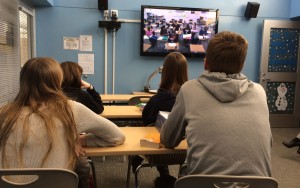From the crowded suburban West Ada School District to the Central Idaho’s remote South Lemhi district — schools are scrambling.

They need to procure high-speed Internet as best they can, and as quickly as they can, with the statewide Idaho Education Network in mothballs.
The schools received a brief reprieve Thursday, when Idaho Education Network contractor CenturyLink said it won’t shut down the system this weekend, even though the state owes the company more than $1 million from the voided network contract. But the clock is still ticking. Fellow network contractor Education Networks of America says it will shut off broadband to districts that don’t sign a contract by Feb. 27.
What are districts doing to keep their high schools wired? Here’s a tour around the state.
West Ada. With or without the network, Idaho’s largest district is “set to go,” Superintendent Linda Clark said Thursday.
If necessary, the district will simply purchase broadband from Zayo, the contractor that already provides broadband to its elementary and middle schools.
West Ada has been taking preemptive steps to prepare for a possible shutdown. For example, the district of 36,000 students has been moving its email accounts off the Idaho Education Network.
The goal, said Clark, is to make sure that any disruption does not affect classes. West Ada uses the network’s videoconferencing equipment to share classes from high school to high school. From fall 2012 through spring 2014, 937 students took classes over the network.
South Lemhi. The district’s Leadore School has a K-12 population of 74 students, and is one of a handful of buildings in the middle of a vast stretch of hills and fields — 120 miles from Idaho Falls, 110 miles from Rexburg and 45 miles from Salmon.
“We are not exactly a prime market for competition in broadband networks,” Superintendent/Principal Michael Jacobson said. “(The network) makes it affordable … We have a very limited technology budget in our district and the cost of providing our own broadband is a daunting task.”
Leadore School doesn’t use the network’s videoconferencing courses. But the school relies heavily on network broadband for course resources. Most middle and high school students take dual credit or online classes through Idaho Digital Learning Academy.
At this point Jacobson is considering all options to continue to supply high-speed Internet, including cell phone hotspotting through Verizon.
South Lemhi’s plight is not unique. Idaho Education News sent out a survey to 140 districts and charter schools to assess the scope of the broadband crisis. Three districts and charters that said they don’t have a broadband backup plan; South Lemhi, the Salmon River School District in Riggins and Vision Charter School in Caldwell.
“We’ll find a way to make it work,” Jacobson said. “In a rural district like ours broadband Internet really levels the playing field for our students, I can’t stress how important it is for all our students.”
Bonneville. In this large district east of Idaho Falls, administrators see a shutdown as only a technological inconvenience. Bonneville already has the infrastructure in place to support broadband, and many options for providers.
Like West Ada, Bonneville uses the network to broadcast a handful of courses between its high schools. About 150 students take these courses, but there shouldn’t be an impact.
“We are going to have to change the configuration of the equipment to move it from a private to a public network,” Bonneville High School Principal Heath Jackson said. “It may take some time, but my understanding is this might not be an issue for us.”
Sugar-Salem. The rural district east of Rexburg already has the infrastructure to continue broadcasting and receiving videoconference classes, and has begun the transition to a new Internet provider.
Superintendent Alan Dunn’s main concern is with his eastern Idaho partners: the Madison, Jefferson County and Ririe districts. The four districts share courses. But if other districts in the consortium can’t find good broadband options, Sugar-Salem students might not be able to finish classes broadcast from remote locations. About 50 percent of the district’s juniors and seniors are enrolled in various network classes.
“The problem is that we can’t hire one teacher (to compensate), because we get a dozen different subjects,” Dunn said. “If it happens we’ll have to reshuffle students into another class, which would be extremely undesirable.”
Boundary County. In the state’s northernmost school district, Superintendent Dick Conley has been in contact with a regional provider to guarantee Internet service.
The district is prepared to go to a month-to-month contract with Frontier Communications or other providers until the end of the school year, if needed.
Losing school Internet access would be a “travesty” for rural districts, Conley said.
“We don’t have a college close to Bonners Ferry,” he said. “Dual enrollment or any exposure to college education is key for students who aren’t sure if college is for them. A college education is more of an unknown for students who live far away from Boise or other college towns.”
Network tools are used at Bonners Ferry High School and the district is planning on expanding to the middle school.
Lake Pend Oreille. On Wednesday morning, Technology Director Randy Wittwer was fielding responses to his plea for assistance from local Internet providers. He was also running numerous “what if?” scenarios and reviewing his priorities for his Bonner County district.
Wittwer wants to avoid downtime and save money — and find a stopgap that will provide adequate bandwidth to run district-wide state testing.
Testing is a widespread concern, since schools will have to administer the online Idaho Standards Achievement Test by Smarter Balanced this spring. About 50 districts and charters responded to the Idaho Education News survey; nearly 60 percent of respondents said a switch in broadband vendors will affect testing.
But at Lake Pend Oreille, it’s first things first. Wittwer is vetting three potential vendors, and he has only a few days to sort through the options.
“A little bit of pressure to be sure and I am in the middle of it as we speak,” he said.
Bailout bill passes House
With little debate, and only one dissenting vote, the House endorsed the last-gasp attempt to keep broadband in the state’s high schools.

House Bill 168 would earmark $3.6 million to reimburse local school districts for short-term broadband contracts. Rep. Luke Malek, the bailout bill’s sponsor, said the plan is an attempt to keep uninterrupted broadband service in Idaho high schools, “so that the politics of this whole thing does not affect the classroom.”
Nonetheless, politics flavored the debate.
House Minority Leader John Rusche, D-Lewiston, pointed out that he was among the original supporters of the 2008 law creating the Idaho Education Network. He said he still supports the idea of a statewide contract, but lamented that this contract failed “in such a stupendous manner.”

Said Rusche: “It’s really with disappointment and sadness that we come to this point.”
Boise Democrat John Gannon cast what he called a protest vote against the bailout, and admonished legislators to shore up the state’s contracting and procurement practices. “We should learn from this experience, and we should learn very quickly.”
With the 68-1 vote, House Bill 168 now heads to the Senate. If senators approve the bill, it goes to Gov. Butch Otter.
Idaho Education News reporter Kevin Richert reported on this story from the Idaho Statehouse. Idaho Education News reporters Nate Sunderland and David Keyes reported from Eastern Idaho and North Idaho.
